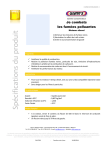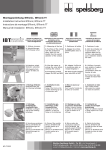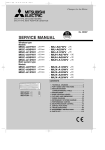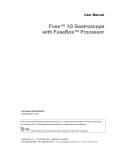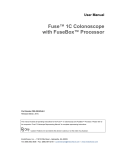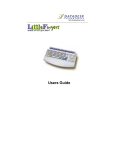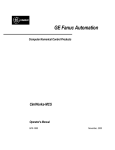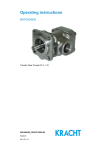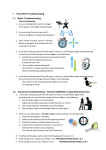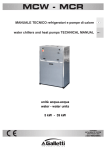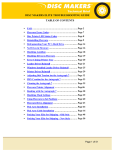Download pick variable flow service manual
Transcript
PICK VARIABLE FLOW SERVICE MANUAL INSTANTANEOUS STEAM INJECTION VARIABLE FLOW HEATER SERVICE MANUAL 1 PICK VARIABLE FLOW SERVICE MANUAL DO NOT DISPOSE OF THIS MANUAL The information on the following pages will be useful after installation. Please direct this manual to personnel responsible for the ongoing maintenance and operator of the Pick Heater. IMPORTANT: DO NOT OPERATE THE PICK HEATER SYSTEM IN PARALLEL WITH ANY OTHER HEATING SYSTEM, INCLUDING A SECOND PICK HEATER SYSTEM. CAUTION: NEVER USE HANDS OR OTHER PARTS OF THE BODY TO SEARCH FOR WATER OR STEAM LEAKS IN THE SYSTEM. HIGH VELOCITY LIQUIDS OR STEAM COULD PENETRATE THE SKIN AND CAUSE SERIOUS INJURY. Any questions about the installation or operation of your Pick Heaters should be directed to your local Pick Heater representative, or Pick Heaters at 800-233-9030. (Outside the US and Canada, please call 262-338-1191 or Fax 262-338-8489.) 2 PICK VARIABLE FLOW SERVICE MANUAL PICK INSTANTANEOUS STEAM INJECTION VARIABLE FLOW HEATER INSTALLATION, START-UP AND OPERATION Warranty……………………………...…………………………….……………………….……..3 Safety information……………...………………………………………………………….………4 Troubleshooting Tables………………………………………………………………………...5-10 Injection Tube Service …………………………………………..………………….……………11 Obtaining the Proper Cleaning Solution ………………………………………………...……….11 Cleaning…………………………………………………………………………………………..11 Heater Disassembly…………………………………………………………………...…….……13 Models 6X10 through 6X500…………………………………………..…………….….13 Model 6X7………………………………………………………………………….……13 Injection Tube Cleaning……………………………………………………………………….….14 Injection Tube Disassembly………………………………………………………………………14 Illustrations……………………………………………………………………….……..…….16-18 Reassembly/Installation of Injection Tube……………...……….………………………..……...19 Heater Reassembly……………………………………………………………………………….19 Pump Service………………………………………………………….……………………….…20 Relief Valve………………………………………………………………………………………20 Steam Control Valve……………………...………………………………………………………21 Steam Valve Opening Pressure Adjustment……………………………………………..21 Packing Gland Adjustment………………………………………………………………22 Temperature Controller Adjustment and Service………………………………………………...23 Other Troubleshooting Issues…………………………………………………………………….24 Replacement Parts...…………………………………………………………………………....…25 The Pick Heater Warranty Every Pick heater is warranted to perform at its rated capacity when properly installed ad maintained, and when operated under the conditions originally specified. Any change in operating conditions, or unauthorized modifications to the equipment, will void this warranty. Every Pick heater is warranted to be free from defective materials or workmanship for one year following installation, or 18 months from the invoice date, whichever occurs first. Any defective parts will be replaced FOB West Bend, WI. Please note that this warranty does not extend to labor or installation costs involving replacement parts. Determination of repair or replacement will be at the discretion of Pick Heaters, Inc. Pick Heaters shall not be liable for losses or delays resulting from damaged or defective parts. This warranty does not cover damage caused by improper installation or adjustment, or by willful neglect of specified operation and maintenance procedures. Equipment not manufactured by Pick Heaters, Inc. which is supplied as a component is not covered by this warranty. However, Pick Heaters, Inc. will pass on to the purchaser any adjustment made by the supplier of any defective equipment. Please read these instructions completely before installing or operating your Pick Heater. 3 PICK VARIABLE FLOW SERVICE MANUAL This symbol is placed in this manual to call attention to safety precautions for the installation and operation of this product. Observe ALL instructions accompanied by this symbol. This symbol means ATTENTION! BECOME ALERT! YOUR SAFETY IS INVOLVED! Be familiar with the varying degrees of hazard represented by the signal words CAUTION and WARNING. CAUTION indicates a need to be aware of situations or conditions which demand greater attention to safety practices when operating or servicing the unit. WARNING indicates a situation demanding full attention to safety precautions due to possible hazards. Segments of information preceded with the word “IMPORANT” should be noted, as damage may occur to the unit or system if detailed instructions are not followed. Note: Most Pick Variable Flow Heaters are used to heat water. However, these units also find extensive service in processing a water-miscible products. Installation, maintenance and troubleshooting procedures are not affected b the nature of the liquid being heated. (To avoid complications, this manual uses “water” to refer to any liquid or slurry being heated.) 4 PICK VARIABLE FLOW SERVICE MANUAL TROUBLESHOOTING Pick heaters rarely require troubleshooting or repair, thanks to the simplicity of design and operation. Many apparent difficulties with heater operation are actually the result of a problem or adverse condition in the steam supply system, or product supply and distribution lines. The following pages are to direct the technician through a logical approach for system troubleshooting. General problem are shown in the header of each table. Key physical observations are listed in the OBSERVATION column. PROBABLE CAUSE is the likely cause of the problem and ACTION indicates the suggested operation to resolve the problem. The PAGE column directs the technician to additional service or repaid instructions for the suggested action, if applicable. If you are not able to solve a problem with your heater as described in these pages, or if your problem is not cocered in this manual, please contact your local Pick representative or call Pick Heaters at (800) 233-9030. (Outside the US and Canada, call 262-338-1191 or Fax 262-3388489.) PROBLEM: Heater will not heat liquid to the desired temperature. OBSERVATION PROBABLE CAUSE ACTION Steam control valve is Insufficient supply air Check air supply, set FULL CLOSED pressure filter regulator at 20 psi Temperature controller Check temperature problem controller components and air supply. See separate manual for optional temperature controller. RTD failure, or polarity on Check wiring for loose I-to-P Transducer (+/-) may connections, refer to be reversed (optional separate manuals for electronic controller only) wiring diagrams. Steam control valve is Improper controller Increase controller PARTIALLY OPEN calibration setting and re-calibrate Inadequate air pressure Check air pressure supplied, set filter regulator at 20 psi I-to-P tranducer calibration Calibrate I-to-P per (optional) separate manual Steam valve actuator spring Adjust actuator per out of adjustment separate manual Steam control valves Water flow is higher than Reduce water flow rate is FULL OPEN originally specified Check specifications on heater order, compare to actual operating conditions PAGE 21 21 20 5 PICK VARIABLE FLOW SERVICE MANUAL Steam control valves is FULL OPEN (continued) Temperature rise may be greater than originally specified Adjust heater operating demand to original specifications. Consult factory for upgrade to a different heater or steam valve if demand can’t be altered Plugged steam strainer basket Remove steam line basket, empty debris, flush basket and reinstall Clean injection tube. Contact factory for possible alternate materials Disassemble and inspect injection tube. Repair injection tube or return to Pick Heaters for complete reconditioning. Increase steam supply pressure at boiler or PRV. Consult Pick Heaters for re-sizing of steam valve. Confirm boiler output, and overall steam requirements. Confirm that all steam supply valves are open -Check for restrictions in steam supply piping. -Upgrade supply pipe size (see “Steam Supply” section for steam line sizing calculations) -Install pressure reducing valve -Consult factory -Reduce setting Deposit accumulation on injection tube Damaged injection tube Steam boiler or pressure reducing valve (PRV) set lower than specified Steam boiler undersized Steam supply valve NOT FULL OPEN Steam supply piping or components are undersized or restricted Water pressure is too high Supply pressure higher than design Water pressure reducing valve is set too high PROBLEM: Heater will not heat liquid to the desired temperature. OBSERVATION PROBABLE CAUSE ACTION Pump not circulating water Inspect and repair pump as necessary 22 14 12-13 23 See Installation Manual 22 23 PAGE See parts list 6 PICK VARIABLE FLOW SERVICE MANUAL Malfunction in the pump look check valve Capacity of heater is exceeded Steam inlet pressure varies Steam valve has a jerky motion Faulty temperature controller Boiler or supply not adequately sized to provide enough steam to accommodate all demands in the steam system Steam quality may be poor (excess condensate entrained in system) Steam valve packing gland too tight Air leak in the control line Steam valve oscillates *PID- Proportional Integral Derivative, the tuning parameters on some electronic and pneumatic temperature controllers Inspect and repair check valve as necessary Consult Pick Heaters for heater upgrade information Repair or replace controller Check steam supply sizing and boiler for pressure fluctuations Install a drip leg with a steam trap upstream of the strainer, to maintain high quality steam at the heater. Adjust steam valve stem packing gland -Use Soap solution to detect any leaks -Repair leaks or replace line Optional temperature Tune the controller per controller not properly tuned controller manual. *(PID Parameters) Refer to detailed Injection tube problem instructions for Stuck piston disassembly and Plugged Orifices inspection of the heater Broken spring and injection tube -Bleed air from the Air or gas trapped in a high system point of the supply or the discharge piping creating an -Remove surge tank -Install automatic air unstable condition vent valve(s) at system high points Water and steam pressures Check operating too close together pressures Reduce water pressure or increase steam pressure 21 22 See Installation Manual 21 21 12-14 23 7 PICK VARIABLE FLOW SERVICE MANUAL PROBLEM: Noisy Heater Operation. OBSERVATION PROBABLE CAUSE Air trapped in a high point of the cold water supply or the hot water header, creating an unstable condition Distribution branches not connected to the top of water headers USE-POINT control valves opening or closing too rapidly Cross-connection between the hot water line and another water line Water and steam pressures too close together Unstable water pressure valve in system Shock absorber or pulsation dampener device in the system Supply water pressure may be unstable Continued next page ACTION Bleed air from the water system Install automatic air vent valve(s) Check connection of distribution branches, re-pipe if necessary or Add automatic air bleeds at system high points -Readjust rapid-acting control valves -Adjust or repair valves as necessary to allow smooth operation -Eliminate sources of water pressure spikes or upsets -Visually trace all lines to locate possible crossconnections -Eliminate the crossconnection with installation of check valves or other valving -Check operating pressures -Reduce water pressure or increase steam pressure -Observe operation of all valves with steam to the heater turned off -Adjust or replace faulty valves as necessary Remove all shock absorber devices (surge tank) -With steam off, inspect water supply system or pressure, and correct as necessary -Install water pressure control valve if required PAGE 23 23 23 8 PICK VARIABLE FLOW SERVICE MANUAL Steam quality may be poor (excess condensate entrained in steam Steam control valve positioned less than 20% open (operating below minimum turndown) Steam control valve moves too fast (only with nonstandard or faulty temperature controller) Injection tube problem Crack or hole in steam flow Steam control valve moves too fast due to use of valve positioner(s) Steam valve opening pressure out of adjustment Valve packing gland too tight Unstable steam pressure reducing valve upstream of the system -Examine the steam system, correcting any deficiencies -Install a drip leg with steam trap, upstream of the strainer, to maintain high quality steam at the heater Check steam valve travel when operating. Valve must be open more than 20% open. Consult Pick Heaters about a smaller or dual steam valve arrangement The temperature controller should be tuned to allow 7-10 seconds for full valve travel Refer to detailed instructions for disassembly and inspection of the heater and injection tube. Replace piston, spring or injection tube if required Repair or replace inlet house. CONSULT FACTORY Remove valve positioner(s) See installation manual Adjust valve according to steam valve instruction manual Adjust packing gland according to valve manual 20 21 11-13 21 Examine reducing valve, repair or replace if necessary 9 PICK VARIABLE FLOW SERVICE MANUAL PROBLEM: Low Water Flow Rate OBSERVATION PROBABLE CAUSE Supply failure from the water source Broken or plugged pipe fittings, including check valves, gate valves, strainer, etc. ACTION Examine water supply system, correct all problems Inspect water supply lines, replace plugged or faulty components PAGE Clean water strainer basket (if applicable) PROBLEM: Overheated water or steam discharge OBSERVATION PROBABLE CAUSE Particularly after Temperature controller set extended heater too high during initial setup, shutdown or during a previous operating session ACTION Reset controller to the desired temperature -See installation manual for calibration procedure Reset air pressure to 20 psi Air pressure supplied to the temperature controller too high Relief valve not functioning Inspect adjust or repair properly as necessary Inspect and repair as Lead in the steam control valve necessary PROBLEM: Temperature indicator doesn’t agree with controller setting OBSERVATION PROBABLE CAUSE ACTION Water temperature is Temperature controller not Re-calibrate stable and satisfactory properly calibrated temperature controller (See separate manual for optional controllers) PROBLEM: Discolored Water OBSERVATION PROBABLE CAUSE ACTION Problem in the supply water Inspect water lines, system correct any deficiencies Galvanic corrosion due to Install dielectric unions dissimilar metals (between at all connections heater and system piping) between the heater and copper piping Problem in the steam supply Examine the steam system supply system, correct any deficiencies PAGE 19-20 20 PAGE 21 PAGE 23 10 PICK VARIABLE FLOW SERVICE MANUAL INJECTION TUBE SERVICE INJECTION TUBE ORIFICES PLUGGED The most common cause of this problem is hard water. When hard water is heated above 120°F the lime in the water precipitates out of the water and coats the injection tube and other surfaces These deposits can be removed by circulating an appropriate cleaning agent through the heater and pump loop. WHEN TO CLEAN THE PICK HEATER How often a Pick heater will require cleaning depend son the composition of the water being used, the length of time the heater is in operation, the quantity of water heated, and the temperature to which the water is heated. Because these factors vary from one application to another, no fixed rules or schedules are possible. (Pick heaters may require cleaning once per year, once each month- or even more frequently). Periodic inspection is the only sure way to determine the proper interval between cleaning. IMPORTANT- A significant drop in hot water temperature (below the level the heater has been producing regularly) indicates that the Pick heater has internal lime deposits, and should be cleaned. OBTAINING THE PROPER CLEANING SOLUTION The cleaning solution should be formulated such that it will not attack copper bearing alloys, (e.g. brass and bronze), cast iron, steel or stainless steel. (316SS). Some descaling agents can cause hydrogen embrittlement, which may result in injection tube spring failure, or cracking of the injection tube. Inhibited dilute muriatic acid is widely used with satisfactory results. WARNING: The use of improper cleaning solvents may result in reduced product life or even in catastrophic failure. If the heater is used in potable water service all cleaning chemicals should be FDA approved. TABLE 1- Cleaning Solution Capacity Heater Model Gallons (approx) 6X7 1 6X10 1 6X25 2 6X50 4 6X75 6 6X100 11 6X150 16-31 6X200 24-53 6X350 31-58 6X500 55-97 Capacity of larger heaters depends on the size of the associated piping INTERNAL CLEANING WIHTOUT DISASSEMBLY For best results, the cleaning operation should be undertaken when the internal lime deposits are wet. If the internal deposits are allowed to dry before starting the cleaning procedure, cleaning will be much more difficult. WARNING: The resulting chemical reaction will produce foaming and gasses, particularly if it is poured rapidly. Provide adequate ventilation. WARNING: Be sure to follow the manufacturer’s instructions when handling the descaling agent. As a minimum, wear safety goggles ad rubber gloves. A breathing filter may also be required. 1. Obtain a supply of cleaning solvent from your local chemical supplier. SEE TABLE 1 for the approximate quantity of solvent needed. Follow 11 PICK VARIABLE FLOW SERVICE MANUAL 2. 3. 4. 5. 6. 7. 8. 9. 10. these steps in sequence to clean your Pick heater without disassembling the unit. Close the air supply valve. Turn the pump motor OFF Close the stem supply, water outlet, and the water supply valves. Drain the heater completely by opening the drain valves under the pump and the heater. Remove the pipe plug (or blind flange on flanged piping) from the tee above the heater. Remove the temperature indicator. IMPORTANT: The open temperature indicator port will provide a vent for gasses that may be formed during the cleaning operation. On flanged systems a short stand pipe must be installed in the temperature indicator port. It should extend6” above the top of the outlet horizontal outlet pipe. Close the drain valves under the pump and heater. Carefully pour cleaning solvent into the opening at A. Slowly fill the heater to the level of this opening. SEE FIGURE 1. On flanged units only fill horizontal outlet 1/3 to ½ full- DO NOT fill above temperature indicator port. Turn on the pump motor. Allow the cleaning solvent to circulate in the heater for approx. 60 minutes, running the pump motor throughout this period. The time required to clean the Pick heater will depend on how much lime deposit is on and in the injection tube assembly. A good indication of when the unit is clean is the cessation of foaming. Turn off the pump motor. Drain the cleaning solution into suitable containers by opening the system drains. Be sure to follow manufacturer’s cleaning instructions for handling, storing or disposing of the material. Many cleaning agents can be used more than once before losing effectiveness. Consult a local chemical supplier. 11. Reinstall the temperature indicator and pipe plug (blind flange). Flush the heater completely by opening the water supply valve, while leaving the drain valves open. Turn on the pump motor. When the water exiting form the drain valves is clean and clear, close the drain valves. Open the water outlet valve. Open the use point nearest from that location until the water is clean and clear. Close the use point valve and turn off the pump. 12. The Pick heater is now ready to be returned to service. Please refer to normal heater startup procedures in the Installation Manual. NOTE: The piston in the injection tube must be free to respond to variations in steam flow. If restricted, hammer or vibration will result. Disassembly is a straightforward and relatively simple procedure, subject to a few common-sense precautions. Before proceeding with disassembly, please read this entire section carefully to avoid damage to your heater. HEATER DISASEMBLY IMPORTANT: The following parts are required for proper re-assembly. Make sure parts are on hand before taking the unit out of service for maintenance or cleaning. SEE FIGURE 1 The body of a Pick heater (except Model 6X7) consists of two housings that are flanged together. Before proceeding, be sure a replacement gasket is available for reassembly. If the injection tube is disassembled, new stainless steel bolts and flexlock nuts will be required to properly install the spring stopper. See TABLE 2 for quantity for each heater model. 12 PICK VARIABLE FLOW SERVICE MANUAL TABLE 2 Size and QTY of Injection Tube Fasteners Heater Bolt Size Quantity Model 6X7 ¼-28 1 Shoulder Bolt 6X10 ¼-28 x 5/8 3 6X25 “ 4 6X50 ¼-28 X 3/4 5 6X75 “ 6 6X100 “ 6 6X150 “ 12 6X200 “ 12 6X350 “ 12 6X500 “ 18 HEATER DISASSEMBLY- GENERAL INSTRUCTIONS Note: These instructions assume the heater is installed in the vertical-up flow orientation. 1. Shut down the heater by closing the air supply to the temperature controller. 2. Shut off the pump, and disconnect the electric power. 3. Close the manual steam supply valve. 4. Cool the heater if hot, by running cold water through it. Close the cold water supply valve. IMPORTANT: Be sure the steam and water lines are shut off completely 5. Close the water outlet valve (make a note of its position when open) to prevent draining of the distribution system. 6. Drain all water from the heater by opening the drain valves under the pump and heater. DISASSEMBLY OF MODEL 6X10 THROUGH 6X500 1. Remove the heater housing bolts. 2. Disconnect the union in the horizontal outlet piping on threaded units. On welded assemblies remove the outlet assembly between heater and outlet valve. 3. Carefully remove the outlet housing, lifting it straight up until it is completely clear of the injection tube. SEE FIGURE 3 CAUTION: The weight of the outlet housing is listed in the table shown in FIGURE 1. To avoid injury, provide mechanical assistance when handling housing. IMPORTANT: A minimum clearance above the heater body at least equal to dimension ‘D’ in FIGURE 1 must be available to remove the outlet housing. Life the outlet housing straight up, using care to prevent accidental contact between the housing and the injection tube during lifting, damage to the injection tube may result. REMOVING THE INJECTION TUBE The injection tube is machined to close tolerances and is threaded into the inlet housing. It can be removed with a pipe wrench or chain wrench. Place the wrench over the rivets near the threaded end of the tube. If additional force is required, a second wrench can be applied over the bolts holding the spring stopper, at the opposite end of the tube. SEE FIGURE 3. IMPORTANT: To avoid damaging the injection tube, apply the wrench on the rivet area only. Do not apply the wrench to the area containing orifices, i.e., between the rivets and spring stopper retaining bolts. DISASSEMBLY AND INSPECTION OF THE MODEL 6X7 HEATER The body of the 6X7 heater consists of a single housing. See Figure 4 13 PICK VARIABLE FLOW SERVICE MANUAL 1. Disconnect the steam line union located between the steam valve and the heater. 2. Loosen the double-end bushing onequarter turn, and remove the steam line nipple to facilitate removal of the double-end brushing. 3. Unscrew the double-end bushing from the heater housing and remove the injection tube assembly if required. (Most service procedures can be performed with the tube in the bushing.) IMPORTANT: The injection tube is machined to close tolerances and is a key component of your Pick heater. It can be removed from the double-end bushing an 8-inch pipe wrench. Larger wrenches are not recommended. IMPORTANT: The proper location for placement of the wrench is between the threads and the roll in the tube SEE FIGURE 4. INJECTION TUBE INSPECTION (ALL MODELS) Inspect the injection tube. If mineral deposits are evident, clean the tube as described in Injection Tube Cleaning. The piston must move freely in the tube. Use a clean rod, placed in the threaded end of the tube. Manually move the piston through is full travel. Work the piston up and down several times. It must move to the spring stopper and return smoothly. If the piston does not move smoothly, proceed with disassembly ad further inspection of the injection tube components. Note: The injection tube assembly can be returned to the factory for prompt and comprehensive servicing. Cleaning, inspection, and repair or replacement of parts will be performed as necessary to return the part to original specifications. Many customers keep a spare injection tube on hand to minimize downtime during maintenance. INEJCTION TUBE CLEANING (ALL MODELS) CAUTION: When handling and using a cleaning solution, be sure to follow the manufacturer’s instructions to prevent personal injury or damage to equipment. As a minimum, wear goggles and rubber gloves. The cleaning should be performed in a location with good ventilation. It is not necessary to remove the piston for cleaning if the piston is not stuck. If the piston moves freely in the tube and no damage is noted, proceed with cleaning. Submerge the injection tube assembly in a container of cleaning solution- (descaling agent). Refer to OBTAINING THE PROPER CLEANING SOLUTION Section, page 11, for recommended cleaning solutions. After 30 minutes, flush the injection tube with water. Inspect the injection tube to determine whether all the scale has been removed. BE SURE THE PISTON MOVES FREELY INSIDE THE TUBE. If necessary, re-submerge the tube in the cleaning solution. When all scale is removed, and the piston moves freely, flush completely with water. Reinstall the injection tube assembly, then reassemble the heater, per the following instructions. IMPORTANT: Do not leave the injection tube assembly in the cleaning solution longer than required. Extended contact may damage the spring or tube. INJECTION TUBE DISASSEMBLY CAUTION: The spring stopper is under a moderate spring load. Hand pressure can restrain the spring force. However, care should be exercised when removing the 14 PICK VARIABLE FLOW SERVICE MANUAL stopper during injection tube disassembly. foreign material wedging between the piston and the tube. DISASSEMBLY (MODELS 6X10 THROUGH 6X500) SEE FIGURE 3. Thoroughly clean the outer surface of the piston and the inner surface of the injection tube. Remove any sludge, welding slag or other foreign material from inside the tube. If necessary, sue a descaling agent to remove lime deposits. Refer to the discussion of cleaning fluids on page 11. Remove the nuts and bolts retaining the spring stopper from the unthreaded end of the tube. Remove the spring stopper and spring, and inspect each part for wear or damage. Depending on the condition of the injection tube, it may be necessary to grasp the spring stopper with a pliers, while lightly tapping the outside of the injection tube. IMPORTANT: DO NOT clamp the injection tube in a vise to perform maintenance. DISASSEMBLY (MODEL 6X7) SEE FIGURE 4. Note: Clean and inspect the steam elbow in the inlet housing and any other piping where debris may have accumulated. Remove any burrs from the piston and tube. The piston must move freely inside the tube before reassembly. Scoring of the piston or injection tube will not cause a problem as long as the piston moves freely. Remove any high points cause by scoring. To examine the piston and spring, remove the shoulder bolt that holds the spring stopper in the injection tube. A 1/8” Allen wrench is required to remove the shoulder bolt. STUCK PISTON (ALL MODELS)A stuck piston is usually the result of 15 PICK VARIABLE FLOW SERVICE MANUAL 16 PICK VARIABLE FLOW SERVICE MANUAL 17 PICK VARIABLE FLOW SERVICE MANUAL 18 PICK VARIABLE FLOW SERVICE MANUAL REASSEMBLY AND INSTALLATION OF THE INJECTION TUBE (ALL MODELS) SEE FIGURE 3 Be sure the inside of the injection tube is clear of all deposits and foreign material. Note that, in some heaters, the piston and spring stopper have the same outside diameter but are NOT interchangeable. The piston has a .055” hole in the center of the flat end, while the spring stopper has a ¼” or larger hole. Reinstall the piston in the tube so the pillow or open side of the piston is facing the spring stopper end of the tube, allowing the spring to fit inside the piston. Reinstall the spring and spring stopper. IMPORTANT: (Model 6X7 only) Install the spring stopper with the open end over the spring. The spring stopper will rest under the shoulder bolt. SEE FIGURE 4 The spring stopper injection tube has scribe marks (on the end of the tube) that indicate the proper positioning for alignment of the spring stopper bolt holes (except model 6X7). Reinstall the bolts that hold the spring stopper in place, but DO NOT re-use the old nuts. IMPORTANT: Install NEW stainless steel flexlock nuts to insure proper locking. Replacements can be obtained from Pick Heaters. SEE TABLE 2. (Page 12) The model 6X7 injection tube uses a shoulder bolt to hold the spring stopper in place. Use a new stainless steel flexlock nut when re-assembling. SEE TABLE 2 After the injection tube is reassembled, make sure the piston operates freely. Check to be sure there is no binding or restriction in the tube by manually working the piston through its full travel several times, using a length of CLEAN rod. HEATER REASSEMBLY (MODELS 6X10 THROUGH 6X500) Inspect the inlet housing elbow and associated piping for lime deposits and debris. Remove any foreign material. Examine the threads for damage. Apply a moderate amount of paste-type pipe sealant with Teflon to the injection tube threads. Note: Sealant must be FDA approved when heating potable water. IMPORTANT: Place the wrench over the rivets, in the same position used when loosening the tube. Tighten snug, but do not over tighten. Applying force by using an extra-long wrench, or by placing a length of pipe over the handle of the wrench, is likely to damage the injection tube. Examine the gasket surface for cleanliness, and install a new gasket. Install the outlet housing. IMPORTANT: Carefully install the outlet housing straight over the injection tube. Avoid contact between the housing and injection tube. Reinstall all heater flange bolts and install nuts finger-tight. Reassemble and tighten the outlet union. If the union is flanged, clean the gasket surface and install a new gasket. Securely tighten all heater flange nuts, working in a cross (alternate) patter. The Pick heater may now be returned to operation. HEATER REASSEMBLY (MODEL 6X7) SEE FIGURE 4 If injection tube was removed from the double-end bushing, apply a moderate amount of paste-type pipe sealant with Teflon to the injection tube threads. 19 PICK VARIABLE FLOW SERVICE MANUAL Note: Sealant must be FDA approved when heating potable water. CIRCULATING PUMP SERVICE Thread the injection tube into the doubleend bushing (the bushing should be clamped in a vise at the flats to prevent damage to threads.) Use an 8-inch pipe wrench to tighten securely. Do not over tighten – excessive force will damage the injection tube. CAUTION: Be sure the pump motor is turned off and the electrical supply is locked out before servicing the pump. IMPORTANT: To avoid damaging the injection tube, apply the wrench on the area between the threads and the roll only. Applying the wrench to the area containing the orifices may distort the tube and result in the piston sticking. Install the bushing and injection tube into the housing, using pipe sealant on the threads. Reinstall the steam piping and union. Securely tighten all joints. The heater may now be returned to operation. PUMP SERVICE The function of the pump is to provide accurate temperature control over varying flow rates. The pump creates a high rate of water flow through the heating chamber and over the temperature control sensor. This permits the temperature controller to track changing conditions and maintain accurate outlet temperature regardless of water flow. BASIC PUMP INSTALLATION CHECKS Check the flow direction and rotation of the pump. The arrow on the pump body should show flow from the temperature controller to the heater inlet (normally pumping down.) Be sure the check valve in the pump loop is installed to permit flow in this direction. Check to be sure the coupling is tight on both the pump and the motor shaft if so equipped. (Models 6X100 through 6X500.) Close water inlet and outlet, and steam block valves. Drain water from the heater. Refer to the pump service sheet for detailed pump repairs. Completely assembled bearing housings are available from the factory, if applicable. (Model 6X100 through 6X500) RELIEF VALVE FUNCTION The relief valve has two functions: 1) to dampen pressure spikes, and 2) to permit steam to enter the heater during periods when water is not being used. WARNING: The relief valve must be set to relieve at a pressure between the water and steam pressures. If the relief valve is removed, plugged or set above the steam pressure, overheated water or steam may be discharged into the downstream piping. THIS COULD CAUSE DAMAGE TO THE EQUIPMENT, OR COULD RESULT IN SERIOUS INJURY. ONE POUND OF STEAM HAS A VOLUME OF ALMOST 27 CUBIC FEET WHEN DISCHARGED INTO THE ATMOSPHERE. When water is not being used and all outlets are closed, the heater and associated piping become a closed, filled chamber. As the pump loop cools, the temperature controller calls for steam to maintain the set temperature. Initially, steam can not enter the heater. As the steam valve opens, the pressure in the heater increases until it reaches the relief valve setting. At that point water exits through the relief valve allowing steam to enter and heat the water in the pump loop to the set temperature. The temperature controller then closes the steam valve. 20 PICK VARIABLE FLOW SERVICE MANUAL If water is not relieved from the heater in this manner, the loop water will continue to cool. The steam valve will continue to open, eventually reaching a fully-open position. The closed system will then be at steam pressure. As a result, when a use point is opened, the initial flow may consist of steam. The temperature controller will bring the steam valve back under control as steam passes over it. Meanwhile, this steam will continue through the water piping, to exit at the use point. SETTING THE RELIEF VALVE SEE FIGURE 1. 1. Close the water outlet valve to insure maximum static water pressure. 2. Shut off the compressed air supply to the temperature controller to insure that the steam valve is closed. 3. Close the steam line block valve . 4. Turn the relief valve adjustment screw counter clockwise to establish a strong flow of water through the relief valve. (Access to the adjustment screw may be obtained by removing the castle nut cover seal on some valves). 5. Turn the adjustment screw clockwise (retighten) until the flow of water stops. Note that the valve may drip for a short time until it reseats completely. 6. Tighten the adjustment screw (turn clockwise) an additional ½ turn. Install and tighten the castle nut if so equipped. (It is now set approximately 15 psi above the water pressure. 7. The valve is now reset. The water outlet valve, steam block valve and air supply to the temperature controller, may now be opened. STEAM CONTROL VALVE IMPORTANT: Do not install valve positioners. A valve positioner cases the steam valve to move too fast to a new position, resulting in hammer vibration and poor temperature control. If installed, place in a bypass, dampen or remove the positioner. STEAM VALVE LEAKAGE Overheating of product when the steam valve is closed is an indication of EXCESS LEAKAGE. The maximum leakage rate should not exceed .01% of full open valve capacity (ANSI CLASS IV). Steam leakage can be observed by disconnecting the union or flange between the steam valve and heater, then slowly opening the block valve. CAUTION: make sure that the steam block valve is closed and the heater is drained prior to disconnecting the union or flange. If excess leakage is observed: Check valve travel stop (if applicable) Disconnect the air line from the steam valve actuator. If leakage decreases, either the steam valve opening pressure is less than 3 PSI, or there is a temperature controller o Ito-P transducer problem (if installed) which is holding the steam valve slightly. If the leakage still exists, the steam valve requires repair. Please refer to the valve service manual for instructions. STEAM VALVE OPENING PRESSRUE ADJUSTMENT 1. Close the steam block valve. 2. Set the temperature controller to it’s coldest setting. Note: The following procedure may require two people. People adjustments according to the instructions in the separate actuator manual. 3. Energize the interlock (3-way air solenoid valve) if one is installed. 4. Slowly increase the output of the temperature controller until the 21 PICK VARIABLE FLOW SERVICE MANUAL 5. 6. 7. 8. steam valve begins to open. At this point read the pressure on the I-to-P transducer outlet gauge. A single steam valve or the small valve on a dual assembly should begin to open at 3-4 psi. If the heater has a dual steam valve arrangement, continue to increase the controller output until the second (larger) valve begins to open. There should be a slight amount of overlap between the valves. The first valve should be open about 90% (approximately 9 PSI) when the second valve starts to open. Most steam valves have an adjustment nut at the top of the yoke opening. Turning this into the actuator body increases the opening pressure. Unthreading the nut reduces the air pressure to begin opening the valve. Return the temperature controller output to zero or a negative value. NOTE: There will be some error when adjusting with the steam off because the steam and water should be observed during operation, and further adjustment may be necessary. PACKING GLAND ADJUSTMENT Important: Consult Steam Valve Manual for proper adjustment. Packing gland adjustment is required when either of two conditions exist: 1. Leakage around the valve steam indicates a need to tighten the packing gland nuts slightly or replacing packing. Tighten evenly. 2. Fluctuations in product temperature may be caused by excessive drag between the packing gland and steam valve stem. The steam valve moves in a jerky motion. Slight loosening of the packing gland nuts may correct the condition. WARNING: Loosen packing gland nuts slightly. DO NOT REMOVE NUTS COMPLETELY! If steam leaks around the packing gland, retighten the nuts until the leakage stops. OPERATION BELOW MINIMUM STEAM VALVE TURNDOWN Operating the heater at a steam flow that requires the control valve to be less than 20% open can cause vibration, bounce, flutter or hammer. If your application requires operation under these conditions, a dual steam valve assembly or a smaller steam valve should be installed. Contact Pick Heaters or your Pick representative for more information. NOTE: This situation can be checked by throttling the steam block valve enough to open the steam control valve at least 50%. If the vibration ceases, the steam control valve was operating too close to the seat. AIR LEAKAGE Air leaks between the steam valve actuator and the temperature controller can result in temperature controller problems. Leaks can be detected by coating the area with a soap solution. If bubbles form, a leak exists. Repair all leaks. Possible lead points to check include: • All air piping and connections • The steam valve diaghram may have a hold in it. • The actuator stem O-ring may be cut or worn. TEMPERATURE CONTROLLER ADJUSTMENT AND SERVICE – SEE FIGURE 5 Proper operation and adjustment of the temperature controller is vital to the proper functioning of your Pick heater. A faulty or incorrectly calibrated controller can cause 22 PICK VARIABLE FLOW SERVICE MANUAL temperature control problems; however, several other components also affect temperature control. All should be checked before replacing the temperature controller. CALIBRATION Adjust the controller until the outlet thermometer is at the desired temperature. Loosen the control knob set screw. Turn the knob to the indicated temperature. Tighten the set screw. (A 3/32 inch Allen wrench is required.) ADJUSTMENT OF STANDARD PICK TEMPERATURE CONTROLLERS Confirm the air pressure regulator setting of 20 psi. If the pressure gauge has a dual scale (English/Metric), be sure to take readings from the psi scale (English). IMPORTANT: Manual steam valve and air valves must be closed when servicing the temperature controller. FIGURE 5. Check the sensitivity adjustment screw, located on the bottom of the controller near the air supply inlet. (It may be covered with a sealant which can be removed.) Remove the adjustment screw, and allow air to blow out through the opening to make sure it is clear. Wipe off the needle and resinstall. Turn the adjustment screw in all the way, then open one-half turn. The adjustment screw may need to be further adjusted (a maximum of one-quarter turn in either direction) for best control. Make adjustment in one-eighth-turn increments. Give the heater time to respond between adjustment. Check the supply and control ports. The supply from the regulator enters the controller from the right when looking at the nameplate in the upright position. The left port should be connected to the tubing going to the steam valve. Note: The supply is marked with an “S” and the control port is marked “R” on the bottom of the controller. Check the control knob and calibration. The control knob might be loose and may not actually be turning the shaft. If the stop pin has been sheared, the controller may be one or more turns out of calibration. To check, remove the control knob by loosening the set screw. Turn the shaft to obtain correct temperature. Install the knob to indicate the actual water temperature. Tighten the set screw. REPAIRS OF THE STEANDARD PICK TEMPERATURE CONTROLLERS All needed repairs on standard temperature controllers should be performed at the factory. To minimize heater downtime, Pick Heaters will send a fully-warranted, factory rebuilt temperature controller in exchange for a used controller. Used controllers are reworked and placed in factory rebuilt stock. CONTROLLER LINKAGE ADJUSTMENT Set knob to cold. Remove knob and nameplate to expose inner mechanism. Check movement of thermal valve arm to make sure arm is centered over valve seat and has a slight sideplay. If necessary, correct movement by adjusting pivot screws. Reinstall nameplate and knob. When heater is operating satisfactorily it may be necessary to recalibrate the temperature controller. ADJUSTMENT AND MAINTENANCE OF OPTIONAL TEMPERATURE CONTROLLERS If the Pick heater is equipped with an optional temperature controller, follow the adjustment and calibration procedures as detailed in the separate temperature controller manual furnished with the heater. Service or repair of theses units must be performed by qualified individuals. 23 PICK VARIABLE FLOW SERVICE MANUAL Improper servicing can lead to a malfunction of the heater, and can even result in dangerous operating conditions. Consult Pick Heaters or the local representative if internal servicing is required. HEATER/SYSTEM ISOLATION It is relatively easy to determine whether vibration is due to a problem within the heater and/or supply lines, or is caused by a condition in the hot water distribution system. SEE FIG. 3 HEATER ISOLATION PLUMBINGINSTALLATION 1. Shut down the heater 2. Remove the temperature controller and bushing. Install a short nipple and tee, the same size as the bushing. 3. Install the temperature controller with bushing in one run of the tee. Install discharge piping to the branch of the tee with a manual valve in it. 4. Close the heater outlet valve 5. Start up the heater, discharging the water through the temporary piping. If the heater runs smoothly in this configuration, the problem is elsewhere in the hot water distribution system. If the heater continues to malfunction in this configuration, check the diagnostic table for solution. IF problem cannot be corrected, consult local representative or Pick Heaters. OTHER SYSTEM TROUBLESHOOTING ISSUES 1. If steam pressure is below specification or fluctuates, temperature variations and system vibration can result. A Pick heater cannot perform properly under these conditions. Diminishing steam pressure is often the result of undersizing or restrictions in the steam supply system. If, as the steam valve opens, the pressure falls off at the Pick steam inlet assembly, a restriction in the steam supply line, or limited steam supply exists. The steam line strainer basket may be plugged, restricting steam flow to the heater. DANGER! Close steam block valve before servicing the strainer basket or other steam line component. 2. Steam lines and valving must be sized for maximum steam flow with negligible pressure loss. Manual “globe” valves if used in the steam supply piping should be oversized to minimize pressure drop. 3. A stuck injection tube piston can cause system vibration. The piston must respond to the steam flow variations which are the result of changes in the temperature rise r flow. See injection tube inspection, Page 13. 4. The water pressure must be less than the steam pressure. If the water pressure is close to or greater than the steam pressure, the heater can not be made to work properly. Water temperature variations and vibration often result if the heater is operated under these conditions. In most cases, the water pressure should be at least 20 psi less than the steam pressure. 5. If the water pressure is higher and/or the steam pressure is lower than originally specified, the steam valve may not be large enough for proper operation of the Pick heater. The flow through the steam valve is a function of the supply pressure and pressure drop across the valve. The steam supply pressure and the water pressure at the heater determine the pressure drop across the valve. If this pressure drop is less than originally specified, the maximum flow through the valve 24 PICK VARIABLE FLOW SERVICE MANUAL 6. 7. 8. 9. 10. will be reduced. A larger steam valve (and possible a larger steam line) may be required. If these conditions are suspected, and are preventing proper operation of your heater, please consult the factory. Install dielectric unions at all connections between the Pick heater and copper piping. For the most part, standard Pick water heaters are constructed from iron housings and steel pipe. Directly connecting iron or steel components to copper piping will result in rapid corrosion of the iron or steel, also known as galvanic corrosion. Bleeding air from water lines. Note that water releases dissolved air when heated. The water velocity is normally not high enough to flush air out of the distribution header if take off points exit the bottom or side of the water header. All distribution branches should connect tot eh top of the header, or automatic air vent valve(s) should be installed at the high points of the header. Correct the condition as necessary. Unstable water pressure can cause system vibration and hammer problems. Heavy demands on the cold water supply can cause significant changes in the supply pressure to the heater. A water pressure regulating valve may be required to stabilize the water supply pressure. Use-point valves closing too fast can cause hydraulic shock and a system upset. heater operating difficulties or malfunction. Furnish a description of the problem, including all information contained on the heater nameplate and steam control valve nameplate- manufacturer name, serial number, model number and size. REPLACEMENT PARTS: Replacement parts are available for all Pick heaters. When ordering parts, please include model and serial number of the heater. These numbers are stamped on the outlet and inlet housings of the heater body and on the nameplate. Describe the specific part required, and include the part number. Refer to teh heater parts list, assembly drawing and the other drawings in this manual for specific information. In addition, when ordering replacement valves or valve parts supplied with your heater, please supply the following information from the nameplate on the valve: Type: Size: Manufacturer: Serial Number: IMPORTANT: An incorrectly installed heater will not work properly. Check heater installation carefully; correct piping connections as appropriate. TECHNICAL ASSISTANCE Pick Heaters, Inc. can provide assistance and replacement parts as needed in the event of 25

























